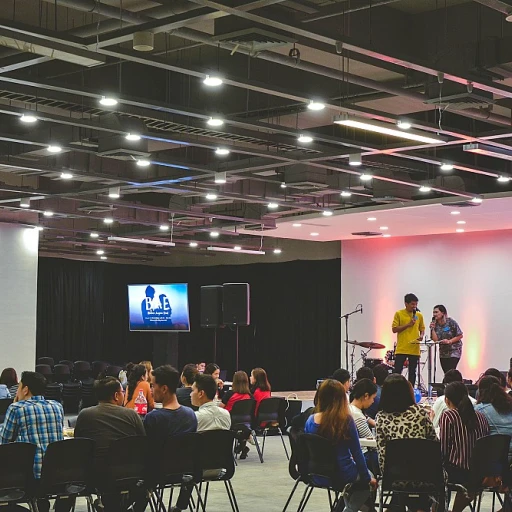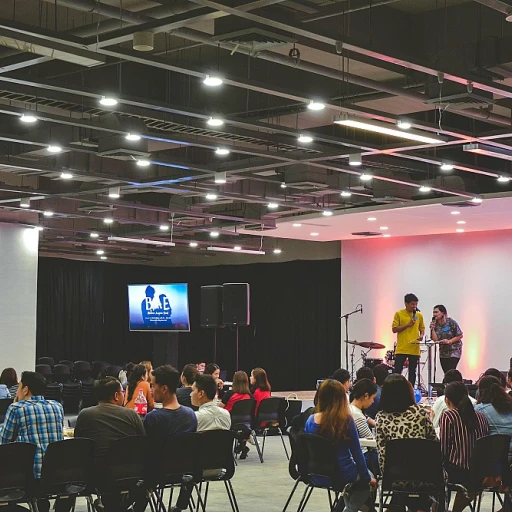
Understanding the Essence of Performance Culture
Defining the Core of Performance Culture
In today's dynamic business environment, understanding the essence of performance culture is crucial for organizations aiming to thrive. At its core, a performance culture is about creating an environment where employees are motivated to achieve high levels of performance consistently. This involves aligning the company's values with its goals and ensuring that every team member understands their role in the organization's success.
Performance culture is not just about setting high expectations; it's about fostering a growth mindset among employees. This means encouraging continuous learning and development, which can be supported by effective career development programs. By investing in higher education and training, companies can cultivate a workforce that is not only skilled but also adaptable to change.
The Role of Leadership and Management
Leaders play a pivotal role in shaping a high-performance culture. They must embody the company's values and lead by example, demonstrating a commitment to excellence and continuous improvement. Effective performance management involves regular performance reviews and feedback, helping employees understand their strengths and areas for growth. This process should be transparent and fair, promoting a sense of trust and engagement among team members.
Moreover, management should focus on building strong teams that can collaborate effectively. This requires creating a supportive organizational culture where people feel valued and empowered to contribute their best work. By fostering a sense of purpose and belonging, companies can enhance employee engagement and drive long-term success.
Linking Culture to Business Outcomes
A thriving performance culture is not just beneficial for employees; it has a direct impact on business outcomes. Organizations with strong performance cultures tend to experience higher levels of employee performance, leading to increased productivity and innovation. This, in turn, can drive business growth and competitiveness in the market.
However, implementing a performance-based culture is not without its challenges. It requires a strategic approach and a commitment to continuous improvement. As we explore further, understanding the role of employer branding and overcoming implementation challenges are key to cultivating a high-performance culture in modern workplaces.
For more insights on how performance culture intersects with employer branding, consider exploring the impact of unlimited PTO policies on employer branding.
Key Elements of a Thriving Performance Culture
Key Elements of Building a Robust Performance Environment
Creating a thriving performance culture involves more than just high expectations; it's about nurturing an environment where employees, teams, and the entire organization can flourish. Here’s a glimpse into the essential elements that constitute a robust performance framework.
First and foremost, having a clear business purpose is vital. When everyone in the company, from management to teams, is aligned with the organizational objectives, a sense of direction and unity develops. This clarity helps in motivating employees and driving their engagement.
Company values play a crucial role in shaping behavior and guiding decision-making processes. These values should resonate through every aspect, from performance management systems to daily interactions. Cultivating a strong set of values helps in building a consistent and unified culture.
Performance reviews and feedback mechanisms are vital tools to help employees understand their strengths and areas for growth. Regularly conducted assessments can facilitate growth mindset adoption, enabling continuous learning and development. It's crucial to shift performance reviews from merely an evaluative process to a trust-based dialogue that encourages growth and innovation.
The encouragement of continuous learning and professional development shapes a high-performing culture. Investing in employee education, whether through workshops or higher education opportunities, creates a culture of advancement and readiness for change.
Finally, fostering an environment that embraces teamwork and collaboration enhances collective performance. When people work together harmoniously, can share knowledge and expertise, and support one another, the overall company culture improves significantly. Teams become more resilient, agile, and ready to tackle challenges as they come.
These elements are interwoven and require commitment and consistency to implement effectively. Only then can organizations witness substantial growth and enjoy long-term benefits of a high-performance culture.
The Role of Employer Branding in Promoting Performance Culture
Employer Branding's Influence on Performance Culture
In today's fast-paced business environment, the intersection of employer branding and performance culture plays a critical role in driving organizations towards their goals. Employer branding goes beyond simple marketing to potential job candidates; it acts as a foundational pillar that influences company culture, employee engagement, and collective performance outcomes. The core mission of employer branding in the context of fostering a high-performance culture is to align the organization's external brand promises with the internal work environment experienced by employees. When employees perceive that the company's values and culture align with their personal and professional aspirations, their level of commitment and productivity increases significantly. This correlation underlines the vital role of management in ensuring that the employer's brand image reflects the true essence of the company's operational culture. Organizations with strong employer brands create compelling narratives around their purpose, team dynamics, cultural values, and growth opportunities. This narrative isn't just for show; it becomes a living, breathing part of the organizational culture that each employee experiences and contributes to daily. As companies strive to retain top talent and maintain a competitive edge, they must build a culture that acknowledges the diverse needs of its people, offering continuous learning and development opportunities that enhance both individual and collective performance. Moreover, employer branding helps to establish an environment where high-performing teams can thrive. Companies demonstrating transparency in their performance management and reviews processes ensure that everyone is rowing in the same direction towards shared goals. Additionally, embedding a growth mindset within the organization's core values supports a culture that rewards adaptability and innovation. In summary, employer branding not only attracts talent but also cultivates the internal environment necessary for a thriving performance culture. To further explore how organizations are leveraging unique partnerships to enhance their performance culture, you can read more here.Challenges in Implementing Performance Culture
Obstacles in Integrating High-Performance Culture
Implementing a high-performance culture within an organization can be a challenging endeavor. Several factors contribute to the complexity of embedding a performance culture that aligns with the company values and supports the growth of both the employees and the business.
One of the primary challenges is resistance to change. Employees, accustomed to long-standing practices and organizational culture, may feel apprehensive about shifting towards a performance-based approach. This change reluctance can hinder the seamless integration of new performance processes and impact the overall employee engagement.
Misalignment between the company’s purpose and the high-performance objectives is another hurdle. For a performance culture to thrive, there must be a clear understanding of how individual and team goals support broader business objectives. This necessitates effective communication from leadership to ensure that every employee recognizes and embraces the organization's mission.
The role of leaders and management is critical in fostering an environment conducive to high-performing teams. Insufficient leadership training and the absence of continuous education can impede the successful transmission of the desired performance culture. Leaders play an essential role in modeling behaviors, providing coaching, and conducting effective performance reviews. Their commitment influences the team's acceptance and execution of performance initiatives.
Lack of sufficient resources and support structures can stall the cultivation of a high-performance culture. To nurture growth and maintain the momentum of performance improvement, organizations must invest in robust performance management systems and tools. This includes dedicating resources to training programs, higher education opportunities, and performance management software that supports real-time feedback and long-term performance tracking.
Lastly, inconsistency in performance processes across different departments or units can create disparities within a company culture. Uniformity in setting performance standards, evaluations, and rewards is vital to prevent confusion and potential demotivation among employees. Organizations must ensure that their strategy promotes consistency to uphold the principles of equity and fairness.
Case Studies: Companies Excelling in Performance Culture
Exemplary Organizations Leading the Way
In the realm of performance culture, certain organizations have distinguished themselves by fostering environments where high performance is not just encouraged but ingrained in the company’s DNA. These companies have effectively aligned their business culture with their strategic goals, ensuring that every employee understands and contributes to the overarching purpose of the organization.
Tech Innovators Setting the Benchmark
Leading tech companies have long been at the forefront of cultivating high-performing cultures. By prioritizing continuous learning and a growth mindset, these organizations empower their teams to innovate and excel. Performance management processes are seamlessly integrated into daily operations, allowing for real-time feedback and agile adjustments. This approach not only enhances employee performance but also drives long-term growth.
Retail Giants Emphasizing Employee Engagement
In the retail sector, some companies have excelled by placing a strong emphasis on employee engagement and organizational culture. By aligning company values with employee aspirations, these businesses create a sense of belonging and purpose. Performance reviews are not just evaluative but developmental, focusing on personal and professional growth. This strategy has proven effective in maintaining high employee morale and productivity.
Financial Institutions Focusing on Purpose and Values
Financial institutions that have successfully implemented high-performance cultures often do so by embedding a strong sense of purpose and values into their organizational framework. Leaders in these companies are adept at communicating the importance of each employee’s role in achieving the company’s mission. This clarity of purpose fosters a culture of accountability and excellence, where performance is consistently aligned with the company’s strategic objectives.
Education Sector Embracing Change and Innovation
In higher education, institutions that thrive in performance cultures often embrace change and innovation. By fostering an environment of continuous learning and development, these organizations encourage both educators and students to strive for excellence. Performance-based initiatives are tailored to support both individual and collective growth, ensuring that the institution remains competitive and forward-thinking.
These case studies illustrate that while the path to cultivating a high-performance culture may vary across industries, the core principles of alignment, engagement, and continuous improvement remain consistent. Organizations that excel in these areas not only achieve superior business outcomes but also create a fulfilling work environment for their employees.
Future Trends in Performance Culture and Employer Branding
Embracing Future Perspectives in Performance and Employer Branding
As businesses continue navigating the complexities of a digital-driven world, understanding future trends in performance culture and employer branding becomes imperative. Organizations striving for growth must harness these insights to nurture a culture high on performance and employee engagement.
Looking ahead, companies are recognizing the evolving dynamics of workplace cultures and management strategies. The shift towards remote and flexible work environments has sparked a need for innovative performance management approaches. Traditional indicators are being redefined, with a considerable emphasis on continuous learning and development, fostering a higher education-inspired culture growth.
- Employee-Centric Performance Processes: As the role of employees becomes more central in driving business outcomes, organizations are crafting performance processes that go beyond mere performance reviews. These processes are becoming more engaging, focusing on continuous feedback and personal growth instead of annual evaluations.
- Integrating Organizational and Personal Purpose: Aligning company values with individual purposes is gaining prominence. This alignment not only strengthens the organizational culture but also enhances employee performance by resonating with personal values and beliefs.
- Technology-Driven Transformation: The integration of advanced technologies, such as artificial intelligence and data analytics, is set to revolutionize performance cultures. These tools assist businesses in analyzing behavior patterns and tailoring performance strategies that are adaptive and responsive to change.
- Focus on Empowering Leadership: Organizations are investing in developing leaders who inspire and empower high-performing teams. The focus is shifting to nurturing leadership qualities that support the team’s emotional and professional needs, driving a stronger commitment to high performance.
While embracing these trends, companies must be prepared to overcome the inherent challenges in integrating such transformative changes into their culture. By fostering an environment where innovation and proactive learning are encouraged, organizations can establish and sustain thriving performance cultures equipped for the future.













